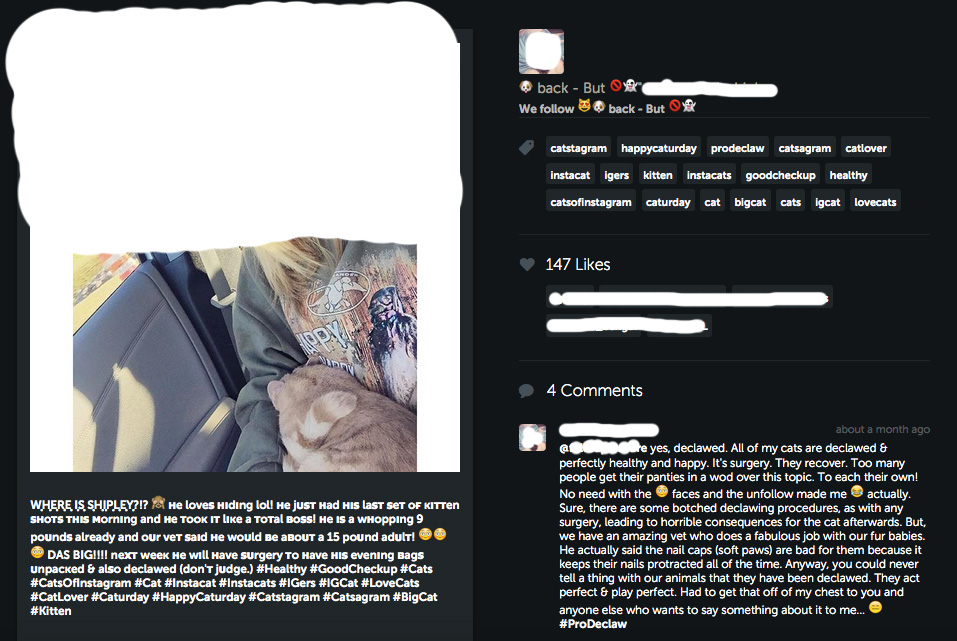Story published in 2016. 
WHERE IS THE PASSION IN THE VETMED PROFESSION TO HELP THE WELFARE OF CATS AND STOP THIS ANIMAL CRUELTY?
The point of this post is to simply shine light on how often many pro-declaw AVMA veterinarians are deceiving their cat owner clients into believing that declawing is a procedure that is ok to do to a cat. Many either sugar coat it and say it is just removing the nails, or it is safe, or many other appalling things that are simply not true.
We believe that this cat owner loves her cats.
We believe she was very misinformed about this mutilating procedure by her AVMA veterinarian. Which is very sad since this is directly harming her beloved cats.
She has her cat in her lap with a big smile after coming back from her vet visit.
We blocked out the name of her cat account (which actually has a lot of followers) and the name of her vet hospital and her face.
We respectfully reached out to her to ask her if she cares that her unethical veterinarian is deceiving her and other cat clients about humane alternatives and making declawing out to be ok for a cat and her reply was, “your opinion doesn’t matter to me” and then blocked me from her cat’s Instagram fan page.
(Please don’t threaten this girl or the vet since then they will turn things around and play the victim. We know the real victims are the cats that are being inhumanely declawed)
Here is the photo of her with her cat on her lap after going to her “amazing” AVMA vet in Mississippi. It’s sad that the photo got 147 likes from people.
Not too smart of her to attach the name of the vet clinic to her photo especially since this vet is lying to her about how soft paws are bad for cats. 
Can you believe that this cat owners 35 yr member AVMA veterinarian told this cat owner that soft paws are bad for cats because they keep their nails protracted all the time? This is a complete lie! THE AVMA even suggest using nail caps in their declawing policy! (AVMA policy at the bottom of this post)
We reached out to two veterinarians about Soft Paws and the vets at Soft Paws and this is what they said about this AVMA veterinarian’s comments, “Many people relate Soft Paws use to acrylic nails use in humans. However, it is completely different. Cats shed the outer layers of their claws on a regular basis. You may have seen evidence of this around areas your cat normally scratches. This continual shedding reveals new claw growth.
The nail caps fall off with the regular growth and shedding of a cat’s claws and do not lead to any problems with nail health.
Also, the nail caps don’t “trap” the claw in an extended position. Cats use a tendon to extend their claws forward and then relax them back to their normal position, much like a human would point their toe with a tendon and then relax it. The caps don’t interfere with this motion at all. It is simply easier to see the thicker nail caps peeking out of the cat’s fur than it is the thin, usually colorless claw tip.”
They also sent me a factual link about clawsCat claw facts
We also wanted to check on how they address declawing at this practice.
When you call them to ask how much it is to get a 3 yr old cat declawed, they ask do you want 2 feet or 4 feet. (A four paw declaw on a 3 yr old cat is extreme animal cruelty)
Also if you ask to get a kitten declawed that you want to adopt, they give you the price for the declaw/neuter surgery which is $288.
If you ask if there are any negative consequences for the declaw, they say this vet does real well at them, they do a lot of them, and they do around 2 a week so he is very skilled at this.
They don’t use one of those $40,000 lasers to amputate the toes, they do it the old fashioned, guillotine way, and say, “he just usually clips them off.”
This practice wants you to know that they use a therapeutic laser to try to heal the toes after they amputated them and they make all the cats come back to check them to make sure their toes are healed up.
This shows you why we must ban declawing. On a modest level, this vet makes at least $30,000 a year amputating kitties toes and claws. Most vet practices charge around $300 and up to do this mutilating procedure so you can clearly see why they don’t want us to ban it.
Greed over the welfare of kitties just makes me so sad and disheartened.
Please sign the official link to ban declawing in NY- NY Bill to Ban Declawing
![]()
Here is the AVMA’s declawing policy which even suggests nail caps AND SAYS IT IS THE OBLIGATION OF THE VET TO PROVIDE CAT OWNERS WITH THE FACTS ABOUT DECLAWING.
Declawing of Domestic Cats
The AVMA strongly encourages client education prior to consideration of onychectomy (declawing). It is the obligation of the veterinarian to provide cat owners with a complete education with regard to the normal scratching behavior of cats, the procedure itself, as well as potential risks to the patient. Onychectomy is an amputation and should be regarded as a major surgery. The decision to declaw a cat should be made by the owners in consultation with their veterinarian. Declawing of domestic cats should be considered only after attempts have been made to prevent the cat from using its claws destructively or when its clawing presents an above normal health risk for its owner(s).
The following points are the foundation for full understanding and disclosure regarding declawing:
- Surgical declawing is not a medically necessary procedure for the cat in most cases. While rare in occurrence, there are inherent risks and complications with any surgical procedure including, but not limited to, anesthetic complications, hemorrhage, infection and pain. If surgical onychectomy is performed, appropriate use of safe and effective anesthetics and perioperative analgesics for an appropriate length of time are imperative. Pain management is necessary (not elective) and required for this procedure. Multimodal pain management is recommended, and there should be a written aftercare plan. The surgical alternative of tendonectomy is not recommended.
- Scratching is a normal feline behavior, is a means for cats to mark their territory both visually and with scent, and is used for claw conditioning (“husk” removal) and stretching activity.
- Owners should provide suitable implements for normal scratching behavior. Examples are scratching posts, cardboard boxes, lumber or logs, and carpet or fabric remnants affixed to stationary objects. Implements should be tall or long enough to allow full stretching, and be firmly anchored to provide necessary resistance to scratching. Cats should be positively reinforced in the use of these implements.
- Appropriate claw care (consisting of trimming the claws every 1 to 2 weeks) should be provided to prevent injury or damage to household items.
- Temporary synthetic nail caps are available as an alternative to onychectomy to prevent human injury or damage to property. Plastic nail caps are usually applied every 4 to 6 weeks.
- Declawed cats should be housed indoors and allowed outside only under direct supervision.
- Scientific data do indicate that cats that have destructive scratching behavior are more likely to be euthanatized, or more readily relinquished, released, or abandoned, thereby contributing to the homeless cat population. Where scratching behavior is an issue as to whether or not a particular cat can remain as an acceptable household pet in a particular home, surgical onychectomy may be considered. (GO TO PETFINDER.COM AND SEE ALL THE DECLAWED CATS IN SHELTERS. ALSO EVERY SHELTER IN AMERICA IS AGAINST DECLAWING)
- There is no scientific evidence that declawing leads to behavioral abnormalities when the behavior of declawed cats is compared with that of cats in control groups. (THIS IS A LIE. THERE ARE STUDIES THAT INDICATE THERE ARE BEHAVIORAL ABNORMALITIES IN DECLAWED CATS)

